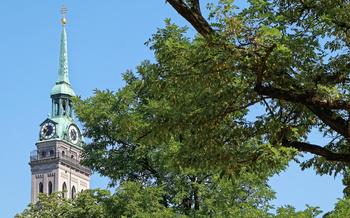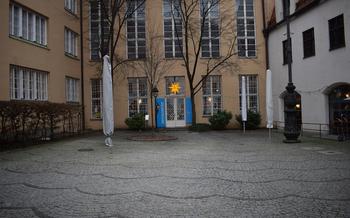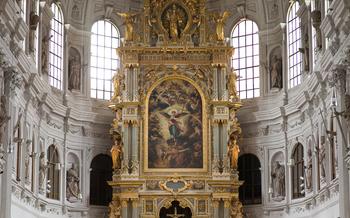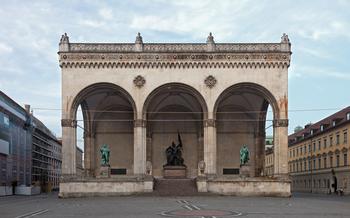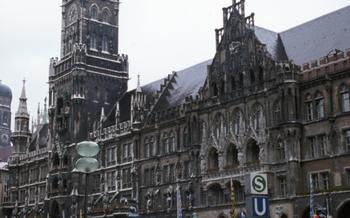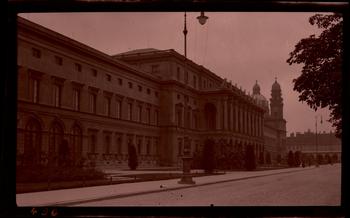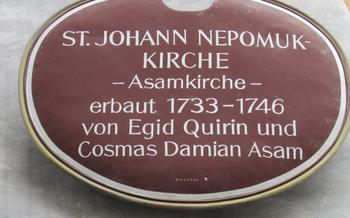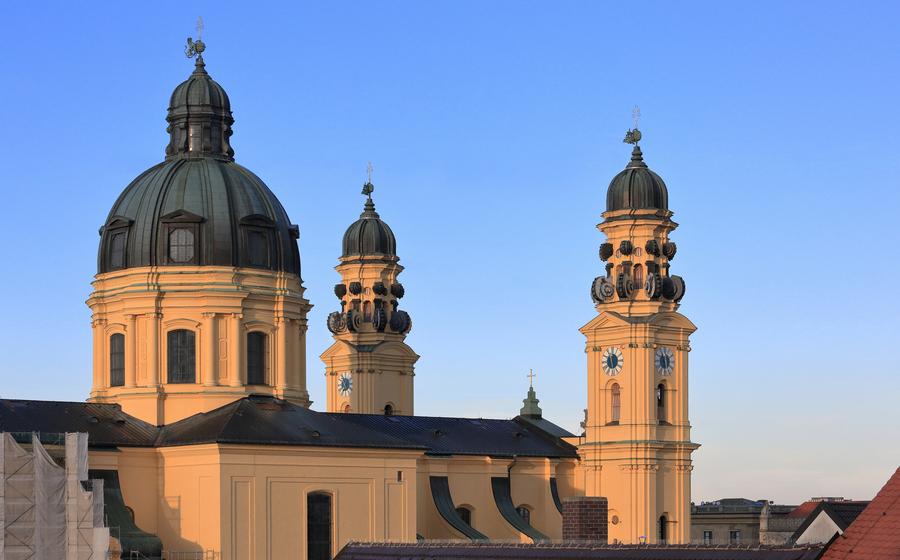
Theatine Church of St. Cajetan
- Theateinerkirche St. Kajetan: A Baroque Masterpiece
- Location and Accessibility
- Opening Hours and Admission
- Exploring the Church's Exterior
- Marveling at the Interior
- Admire the Ceiling Frescoes
- Exploring the Chapels
- Witnessing the Organ
- The Crypt and Burial Sites
- Religious Services and Events
- The Theatine Order and Their Legacy
- Historical Significance and Cultural Impact
- Theateinerkirche in Literature and Arts
- Off-the-Beaten-Path Discoveries
- Insider Tip: Unforgettable Views
Theateinerkirche St. Kajetan: A Baroque Masterpiece
Amidst the vibrant city of Munich, Germany, stands the magnificent Theatine Church of St. Cajetan, a testament to the grandeur of Baroque architecture and the rich religious history of the city. Steeped in artistry and spirituality, this awe-inspiring edifice boasts a fascinating history, remarkable architectural features, and captivating interiors that transport visitors back in time.
History and Background: The Theatine Church, also known as Theatinekirche St. Kajetan, was commissioned by Elector Ferdinand Maria of Bavaria in the 17th century. The church was built as a symbol of gratitude to God for the birth of his heir, Max Emanuel, and as a means to promote the Catholic faith during the Counter-Reformation. The construction began in 1663, and the church was completed in 1690, serving as a testament to the deep religious devotion and artistic patronage of the Bavarian rulers.
Architectural Highlights: The Theatine Church is renowned for its stunning Baroque architecture, characterized by intricate details, graceful curves, and an overall sense of grandeur. Designed by the renowned Italian architect Agostino Barelli, the church features a majestic facade adorned with two imposing towers that soar into the sky. The intricate carvings, sculptures, and ornamental details on the facade showcase the exceptional craftsmanship of the Baroque era.
Interiors and Decorations: Stepping inside the Theatine Church is like stepping into a realm of opulent beauty and artistic splendor. The church's interior boasts a breathtaking nave, adorned with intricate stucco decorations, elaborate frescoes, and gleaming gold embellishments. The high altar, a masterpiece of Baroque artistry, is adorned with sculptures, paintings, and a radiant golden canopy, creating a focal point that commands attention.
Location and Accessibility
The Theatine Church of St. Cajetan is conveniently located in the heart of Munich, Germany, making it easily accessible by various means of transportation. Its address is Theatinerstraße 22, 80333 München, Germany.
Address: Theatinerstraße 22, 80333 München, Germany
Directions:
- From Marienplatz, the central square of Munich, it is a short 5-minute walk southwest.
- From Karlsplatz (Stachus), another significant square, it is approximately a 10-minute walk northeast.
- From Munich Central Station (Hauptbahnhof), take the U-Bahn (subway) lines U1, U2, or U7 to the Marienplatz station and walk as described above.
Public Transportation Options:
- U-Bahn: The closest U-Bahn station is Marienplatz, served by lines U3 and UFrom there, it is a short walk to the church.
- Tram: Tram lines 19 and 21 stop at the Theatinerstraße/Salvatorplatz stop, just steps away from the church.
Parking Availability:
Limited street parking is available in the surrounding area, but it can be challenging to find a spot during peak hours. Consider using public transportation or parking in a nearby parking garage.
Nearby Attractions:
- Residenz München: The former royal palace of Bavaria is adjacent to the church and offers a glimpse into the city's rich history.
- Hofgarten: The beautiful park next to the Residenz is a peaceful oasis in the midst of the city.
- Odeonsplatz: A grand square nearby features significant buildings like the Feldherrnhalle and the Theatinerkirche.
- Viktualienmarkt: Munich's bustling food market is just a short walk away and offers a variety of culinary delights.
Opening Hours and Admission
The Theatine Church of St. Cajetan welcomes visitors with open arms, offering free admission to all who seek to immerse themselves in its sacred beauty. While there are no entrance fees, donations are gratefully accepted to support the church's ongoing preservation and maintenance efforts.
The church adheres to specific visiting hours to ensure tranquility and respect for those attending religious services. On weekdays, it opens its doors from 10:00 AM to 12:00 PM and 2:00 PM to 6:00 PM. On Saturdays, visitors can explore the church from 10:00 AM to 12:00 PM. However, during the summer months, extended hours are implemented, allowing visitors to bask in the church's splendor until 7:00 PM on weekdays and 5:00 PM on Saturdays.
To fully appreciate the church's intricate details and rich history, guided tours are available at a nominal fee. Knowledgeable guides lead visitors through the church's highlights, sharing captivating stories and insights that bring the opulent interiors to life. These guided tours are offered daily at various times, ensuring that visitors can choose a time that suits their schedule.
Audioguides are also available for those who prefer a self-guided exploration. With pre-recorded commentary, visitors can delve into the church's history, architecture, and artwork at their own pace, creating a personalized and immersive experience.
Photography and filming are permitted within the church, allowing visitors to capture the stunning visuals and share their experiences with others. However, the use of flash photography is prohibited to preserve the integrity of the delicate artworks and decorations.
Exploring the Church's Exterior
As you approach the Theatine Church of St. Cajetan, its striking facade and twin towers immediately captivate your attention. The intricate portal, adorned with sculptures depicting scenes from the life of St. Cajetan, invites you to step closer and admire the craftsmanship of the Baroque era.
Take a moment to explore the courtyard surrounding the church, where you'll find hidden architectural details, such as the fountain and the statues of saints that adorn the niches. The courtyard provides a tranquil oasis amidst the bustling city, offering a serene space for contemplation and reflection.
Marveling at the Interior
Step inside the Theatine Church of St. Cajetan, and you will be awestruck by its magnificent interior. The nave, with its soaring barrel vaults, creates a sense of grandeur and spaciousness. The high altar, a masterpiece of Baroque artistry, is a sight to behold. Its intricate carvings, gleaming gold leaf, and vibrant colors depict scenes from the life of St. Cajetan and the Theatine Order.
The side altars and chapels, each dedicated to a different saint or devotion, are equally impressive. The Chapel of St. Anne, with its delicate stucco decorations and elegant altar, is a particular highlight. The Chapel of the Holy Cross features a striking crucifix surrounded by intricate carvings and paintings.
The church's interior is further adorned with stunning stucco decorations and frescoes. The ceiling frescoes, painted by the renowned artist Johann Baptist Zimmermann, depict scenes from the life of St. Cajetan and the Theatine Order, as well as scenes from the life of Christ. The vibrant colors and Baroque illusionistic techniques create a sense of movement and depth, drawing the viewer's gaze upwards.
Admire the Ceiling Frescoes
The Theatine Church of St. Cajetan is renowned for its stunning ceiling frescoes, a testament to the Baroque era's artistic mastery. These awe-inspiring paintings, executed by the renowned Italian artist Giovanni Battista Tiepolo, depict scenes from the life of St. Cajetan, the founder of the Theatine Order. The frescoes also showcase episodes from the life of Christ, rendered with intricate detail and lifelike expressions.
Tiepolo's illusionistic techniques create a sense of depth and grandeur, making the ceiling appear as if it extends into the heavens. The vibrant colors and dynamic compositions captivate visitors, drawing their eyes upward to admire the artistry and symbolism embedded within each fresco. The harmonious blending of mythology, religion, and allegory adds to the overall richness and complexity of the ceiling decorations.
The central fresco, "The Apotheosis of St. Cajetan," is a masterpiece of Baroque illusionism. It depicts St. Cajetan ascending to heaven, surrounded by a celestial host of angels and cherubs. The surrounding frescoes narrate significant events from the life of Christ, including the Nativity, the Last Supper, and the Resurrection. These scenes are interwoven with allegories representing virtues, sacraments, and theological concepts, creating a visually stunning and intellectually engaging experience for the viewer.
Exploring the ceiling frescoes is a journey through the life of St. Cajetan, the history of Christianity, and the artistic genius of Tiepolo. The intricate details, vibrant colors, and illusionistic techniques employed in these masterpieces make them a must-see for any visitor to the Theatine Church of St. Cajetan.
Exploring the Chapels
The Theatine Church of St. Cajetan boasts several chapels, each dedicated to a different saint or purpose. The Chapel of St. Anne, located on the northern side of the church, features an elaborate altarpiece depicting the life of St. Anne, the mother of the Virgin Mary. The Chapel of the Holy Cross, opposite the Chapel of St. Anne, showcases a striking crucifix and a life-size wooden sculpture of Christ on the cross. The Chapel of St. Joseph, situated in the southern part of the church, is dedicated to the foster father of Jesus and houses an intricately carved statue of St. Joseph holding the infant Jesus. Lastly, the Chapel of the Sacred Heart, adorned with beautiful frescoes and stained glass windows, is a place of devotion to the Sacred Heart of Jesus. These chapels, with their unique artistic features and spiritual significance, add to the overall richness and beauty of the Theatine Church of St. Cajetan.
Witnessing the Organ
The Theatine Church of St. Cajetan boasts a magnificent organ that is not only a feast for the eyes but also for the ears. Built by renowned organ builder Johann Michael Stumm in 1763, the organ is a masterpiece of Baroque craftsmanship. Its intricate carvings, delicate ornaments, and gilded pipes create a visually stunning focal point within the church's interior.
Beyond its visual splendor, the organ is renowned for its exceptional acoustics and musical capabilities. With its 42 stops, three manuals, and pedalboard, the organ produces a rich and powerful sound that resonates throughout the church's grand space.
Regular organ concerts and recitals are held at the Theatine Church, allowing visitors to experience the organ's musical prowess firsthand. These concerts feature talented organists performing a diverse repertoire of classical and sacred music, showcasing the organ's versatility and expressive range.
Whether you are a music enthusiast or simply appreciate the beauty of historic craftsmanship, the organ at the Theatine Church is a must-see attraction. Take a moment to admire its intricate details, listen to its enchanting sounds, and let the music transport you back in time to the Baroque era.
The Crypt and Burial Sites
Descending into the depths of the Theatine Church of St. Cajetan, one encounters the crypt, a sacred and atmospheric space that holds the remains of notable figures from the church's history and beyond. This subterranean chamber exudes a sense of reverence and tranquility, inviting visitors to reflect on the lives and legacies of those laid to rest within its walls.
The crypt's origins date back to the early 17th century when the Theatine Order constructed the church. Over the centuries, it has served as the final resting place for members of the order, benefactors, and prominent individuals associated with the church. Elaborate sarcophagi, adorned with intricate carvings and inscriptions, line the walls, each telling a unique story of the deceased.
Among the notable burials in the crypt is that of Elector Ferdinand Maria, who played a crucial role in the construction and patronage of the Theatine Church. His impressive tomb, featuring a life-size effigy of the elector, stands as a testament to his devotion and generosity. Other notable figures interred in the crypt include members of the noble Preysing family, who were patrons of the arts and staunch supporters of the Catholic Church.
Beyond its historical significance, the crypt also boasts artistic and architectural merit. The vaulted ceilings, supported by sturdy columns, create a sense of grandeur and solemnity. The walls are adorned with frescoes depicting scenes from the lives of saints and martyrs, adding a touch of celestial beauty to the subterranean space.
While the crypt is not always open to the public, guided tours can be arranged upon request. These tours provide visitors with an exclusive glimpse into the church's history and the lives of those who have shaped its legacy. The crypt serves as a poignant reminder of the enduring impact of faith, devotion, and the human spirit.
Religious Services and Events
The Theatine Church of St. Cajetan is an active religious site, hosting regular services and special events that reflect its deep spiritual significance. Mass is held daily, with varying timings on weekdays and weekends. On Sundays, special high masses and vespers are conducted, attracting a larger congregation.
Throughout the year, the church celebrates various religious occasions with special services and celebrations. During the Christmas season, a traditional Christmas market is held in the church courtyard, creating a festive atmosphere. Easter services are particularly solemn, with processions, candlelight vigils, and special masses.
Participating in religious services at the Theatine Church is a unique opportunity to witness the profound devotion and faith of the local community. Visitors are welcome to attend services, whether as observers or active participants, and experience the spiritual energy that permeates the church.
The Theatine Order and Their Legacy
The Theatine Order, formally known as the Clerics Regular of the Divine Providence, played a pivotal role in the history of the Theatine Church of St. Cajetan. Founded in 1524 by Gaetano of Thiene and Gian Pietro Carafa (later Pope Paul IV), the order sought to promote a renewed focus on religious life and morality within the Catholic Church. The Theatines were particularly active during the Counter-Reformation, a period of religious and political upheaval in Europe.
In Munich, the Theatines arrived in 1663 at the invitation of the Bavarian ruler, Ferdinand Maria. They were granted the land on which the Theatine Church would eventually be built, and they quickly established a presence in the city. The Theatines were known for their dedication to education, and they founded a school and a seminary in Munich. They also played a key role in the city's religious life, providing spiritual guidance and support to the local community.
The Theatines' legacy in Munich is still visible today. The Theatine Church of St. Cajetan remains one of the city's most prominent landmarks, and the order continues to have a presence in the city, with a small community of Theatines still residing in the Theatine Monastery adjacent to the church.
Historical Significance and Cultural Impact
The Theatine Church of St. Cajetan is a pivotal landmark in Munich, embodying the city's rich Baroque heritage. Its architectural grandeur and artistic significance have made it a symbol of the Baroque period in Germany. The church's innovative design and intricate decorations showcase the Baroque style's opulence and artistry, leaving a lasting impact on the city's cultural landscape.
The Theatine Church stands as a testament to the skill and vision of its architects and artists, who created a masterpiece that continues to inspire and awe visitors. Its harmonious blend of architecture, art, and religious symbolism has made it a popular destination for both locals and tourists alike.
The church's historical significance extends beyond its architectural merits. As a prominent Catholic church during the Counter-Reformation, it played a crucial role in the city's religious landscape. The Theatine Order, known for its dedication to education and missionary work, used the church as a base for their activities in Munich, contributing to the city's spiritual growth and development.
Today, the Theatine Church remains a vibrant center of religious and cultural activity. Regular masses, concerts, and events attract both worshippers and art enthusiasts, fostering a sense of community and preserving the church's legacy. The church's enduring presence ensures that its historical significance and cultural impact will continue to be celebrated for generations to come.
Theateinerkirche in Literature and Arts
The Theatine Church has served as a muse to numerous writers, artists, and creatives throughout history. In literature, it has been mentioned in novels, short stories, and travelogues, often as a symbol of Munich's rich cultural heritage. Its distinctive architecture and intricate details have also inspired painters, sculptors, and photographers, who have captured the church's beauty in various forms.
One notable example is the painting "The Theatine Church in Munich" by the renowned German artist Carl Rottmann, which depicts the church in all its grandeur, surrounded by a vibrant cityscape. The church's distinctive twin towers and elaborate facade are rendered with meticulous precision, showcasing Rottmann's mastery of architectural painting.
Another notable mention is the poem "The Theatine Church" by the Bavarian poet Ludwig Thoma, which vividly evokes the church's spiritual atmosphere and its significance as a place of worship and contemplation. Thoma's words paint a picture of the church's awe-inspiring interiors, where light filters through stained-glass windows, casting a warm glow on the intricate carvings and frescoes.
The church's cultural impact extends beyond literature and painting. Its unique architectural style has influenced the design of other churches and buildings in Munich, contributing to the city's distinctive architectural landscape. The Theatine Church remains a source of inspiration for contemporary artists and designers, who continue to find new ways to interpret and celebrate its timeless beauty.
Off-the-Beaten-Path Discoveries
Beyond the main attractions, the Theatine Church of St. Cajetan conceals hidden gems waiting to be unearthed. Take your time to explore the church's nooks and crannies, and you might stumble upon a hidden altar or a secluded chapel. Look out for unique details and symbols that adorn the church, each with their own story to tell. If you're lucky, you might even discover secret passages or staircases that lead to unexpected places. Don't forget to explore the church's surroundings as well. The nearby streets and alleys offer a glimpse into Munich's rich history and culture, with hidden courtyards, charming cafes, and boutiques waiting to be discovered.
Insider Tip: Unforgettable Views
Timing your visit to the Theatine Church of St. Cajetan is crucial to capturing its beauty. The church's exterior shines under the warm glow of the morning sun, providing excellent lighting for photography. As the day progresses, the interior comes alive with natural light streaming through the stained glass windows, creating a magical ambiance.
Don't miss the opportunity to ascend the church tower for a breathtaking panoramic vista of Munich. From this vantage point, you can admire the city's skyline, including iconic landmarks like the Frauenkirche and the Deutsches Museum. The tower offers a unique perspective, allowing you to appreciate the church's grandeur from above.
When photographing the church's exterior, experiment with different angles to capture its intricate details. The twin towers, ornate portal, and courtyard provide endless opportunities for creative shots. Inside, the majestic nave and elaborate altarpieces demand attention, but don't overlook the smaller details like the delicate frescoes and sculptures that adorn the walls and ceiling.
With a keen eye and a little patience, you can capture the essence of the Theatine Church of St. Cajetan, preserving its beauty for years to come.
